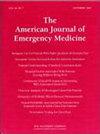手持超声与标准机器在置入外周静脉导管方面的对比:一项随机、非劣效性研究。
IF 2.2
3区 医学
Q1 EMERGENCY MEDICINE
引用次数: 0
摘要
导言:急诊科(ED)经常需要在超声引导下使用静脉导管(USGIV)。这项任务通常使用大型、昂贵的推车式超声系统(CBUS)来完成,而推车式超声系统经常需要用于其他急诊室超声功能,使用和存储都很麻烦。手持式超声系统(HHUs)或许能满足这一需求,但它们在放置 USGIV 时是否能与 CBUS 互换使用,目前还不得而知。我们进行了一项前瞻性、随机、非劣效性研究,以比较 HHU 和 CBUS 放置 USGIV 的成功率:方法: 我们对需要 USGIV 的 18 岁及以上急诊患者进行了接触和登记,并随机分配接受 CBUS 或 HHU 放置的 USGIV。任何接受过置放培训的急诊科医生或护士均可置放 USGIV。一旦针头刺入皮肤,即视为成功置入。如果 USGIV 可以立即用生理盐水冲洗,则为成功。收集的数据包括静脉注射的成功率、尝试次数、静脉注射和提供者特征、患者人口统计学特征以及 USGIV 持续时间。人口统计学、操作者和静脉输液者特征采用皮尔逊卡方检验、费舍尔精确检验或 Wilcoxon 秩和检验进行分析。非劣效性采用 Farrington-Manning 检验进行评估。结果按方案处理,并在 R.Results 中进行分析:共有 312 名患者入组。各组患者和 IV 特征相似。两组成功放置 USGIV 的数量没有差异(p≥0.9),CBUS 组为 146 例,HHU 组为 145 例。两组的首次尝试成功率没有差异(p = 0.8),在成功放置 USGIV 方面,HHU 不逊于 CBUS(p = 0.0001)。HHU和CBUS的USGIV过早失败率相似(4.0%和6.7%):结论:就成功置入 USGIV 而言,HHU 并不比 CBUS 差。各组间首次置管成功率或患者在急诊室处置后 USGIV 存活率没有差异。各级急诊室医护人员在使用 HHU 时都无需接受大量额外培训。本文章由计算机程序翻译,如有差异,请以英文原文为准。
Handheld ultrasound versus standard machines for placement of peripheral IV catheters: A randomized, non-inferiority study
Introduction
Ultrasound guided IV catheter (USGIV) access occurs frequently in Emergency Departments (EDs). This task is often performed using large, expensive, cart-based ultrasound systems (CBUS) which are frequently needed for other ED ultrasound functions and can be cumbersome to use and store. Handheld ultrasounds (HHUs) may be able to meet this need, but it is unknown if they function interchangeably with CBUS for USGIV placement. We performed a prospective, randomized, noninferiority study to compare the success rate of HHUs to CBUSs for placing USGIVs.
Methods
ED patients 18 and older needing an USGIV were approached for enrollment and randomized to receive an USGIV placed by CBUS or HHU. USGIVs were placed by any ED physician or nurse trained in placement. A placement was considered attempted upon needle entry into the skin. An USGIV was successful if it was immediately flushable with saline. Data was collected on the success of IV placement, number of attempts, IV and provider characteristics, patient demographics, and length of time the USGIV lasted. Demographics and operator and IV characteristics were analyzed using Pearson's Chi square, Fischer's Exact test, or Wilcoxon rank sum tests. Non-inferiority was assessed using the Farrington-Manning test. Results were approached per protocol and analyzed in R.
Results
312 patients were enrolled. Patient and IV characteristics were similar between groups. There was no difference in the number of successful USGIVs placed in either group (p≥0.9) with 146 in the CBUS group and 145 in the HHU group. There was no difference in the first attempt success rate between groups (p = 0.8) and HHU was noninferior to CBUS for successful USGIV placement (p = 0.0001). The rate of premature USGIV failure was similar between HHU and CBUS (4.0 % and 6.7 %).
Conclusion
HHU was noninferior to CBUS for successful USGIV placement. There was no difference in the rate of first attempt success at placement or USGIV survival to a patient's ED disposition between groups. No significant additional training was required for ED providers of all levels to use the HHUs.
求助全文
通过发布文献求助,成功后即可免费获取论文全文。
去求助
来源期刊
CiteScore
6.00
自引率
5.60%
发文量
730
审稿时长
42 days
期刊介绍:
A distinctive blend of practicality and scholarliness makes the American Journal of Emergency Medicine a key source for information on emergency medical care. Covering all activities concerned with emergency medicine, it is the journal to turn to for information to help increase the ability to understand, recognize and treat emergency conditions. Issues contain clinical articles, case reports, review articles, editorials, international notes, book reviews and more.

 求助内容:
求助内容: 应助结果提醒方式:
应助结果提醒方式:


